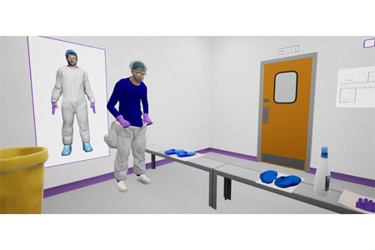Addressing The GMP Skills Shortage With Virtual Reality

By Tyler Menichiello, Chief Editor, Bioprocess Online

Last March, the Alliance For Regenerative Medicine released a report analyzing the workforce gap in the CGT sector. According to this analysis, the biggest gaps are currently in manufacturing and analytical development. The manufacturing gap, in particular, is expected to grow the most in the coming years (according to this study by Deloitte and The Manufacturing Institute).
This biomanufacturing skills shortage is being driven by several key factors: an increasingly successful CGT sector (higher demand for product), technological evolution (ever-changing skills requirements), and an overall lack of people being trained in ATMP manufacturing. In the U.K., a professor at the University of Birmingham is adopting a unique approach to help address this third factor — using virtual reality (VR).

Dr. Ivan Wall is a professor of regenerative medicine and director of the National Training Centre For Advanced Therapies Manufacturing. He is also co-founder and CEO of FourPlus Immersive — a company that makes VR training simulations for medicine manufacturers — and he’s been using VR to train students and apprentices alike in GMP biomanufacturing since 2021. Recently, I had the chance to meet with Wall and discuss his innovative approach to GMP training, as well as other efforts to manage the growing global skills shortage.
Industry Growing Pains
According to Wall, the CGT manufacturing skills shortage is primarily the result of the sector’s rapid growth, and its origins can be traced back to around 2015. “Once we started seeing success in emerging cell immunotherapies, we started to see a paucity of people who had the skills and know-how to go into clean rooms and make these therapies,” he says.
Since then, despite the sector’s continued growth, the problem has only exacerbated. Not only are fewer people coming into the sector, but the technology to manufacture CGTs is constantly evolving. As a result, skills requirements are in a state of perpetual flux.
“We’re not able to keep pace with making sure these people are trained and fit to go into the workplace,” Wall tells me. “As the sector has become increasingly successful, we’ve been trying to play catch up in terms of providing enough people to do the job.”
Wall began thinking about ways to address the apparent, growing skills shortage around 2017. “It was 2019 when I thought that VR would be a really valuable approach,” he says. His company, FourPlus, was started in 2020 at the beginning of the COVID-19 pandemic.
“We were actually going to delay a little bit because we thought we’d struggle to do customer engagement with everyone in lockdown,” he recalls. “But we realized there was an urgent need to support training in some form when people weren’t able to go into real labs, particularly university students.”
Since 2021, Wall has been working with the U.K.’s Catapult Network, a government-funded, not-for-profit organization dedicated to fostering the growth of the region’s CGT sector. “If apprentices are working in cell and gene, they come through Catapult,” he tells me. Catapult uses Wall’s VR training to get apprentices onboarded in its GMP facilities. These same apprentices have gone on to work at companies like Pfizer, GlaxoSmithKline (GSK), and AstraZeneca, as well as CDMOs throughout the U.K.
Improved Safety And Cost Effectiveness
To be clear, FourPlus doesn’t make VR headsets — it makes training programs that institutions can license and download to standalone, untethered VR headsets (e.g., a Meta Quest or PICO Neo3). “You can load the software onto them, and you’ve got something that’s very portable. Trainees don’t have to be locked within a particular room in the university or a facility; they can take them home and do GMP training in their living room.”
Along with versatility, Wall says, using VR headsets to train people for industry has several key advantages. Commercially, it provides a more cost-effective and environmentally friendly approach to GMP training. Aside from the millions of dollars’ worth of equipment found in GMP facilities, biomanufacturing often relies on costly, single-use plastic technologies. “A single-use tube set to make one patient’s product can cost £10,000 (approximately $12,750),” Wall tells me. “If you train someone with one of those, then you have to incinerate it, and that’s a huge cost. Whereas if you can train someone to do it nine times in VR, then they just have to do it once as a validation in real life. This significantly reduces training costs — both in terms of financial and environmental impact.”
Allowing students to practice biomanufacturing in VR also presents an advantage in terms of safety. Biomanufacturing processes are laden with chemical and biosafety hazards that pose a serious risk to anyone learning these techniques for the first time. With VR, students can practice safely and build their competency — all while avoiding toxic spills.
Building A Competent, Diverse Workforce
According to Wall, another key advantage virtual training offers is improved accessibility and preparedness, which in turn supports a diverse and competent workforce. “In a university, you don’t generally have access to the equipment you would be using in an industry setting,” explains Wall. “Someone can graduate with a piece of paper saying they’re competent in biology or chemical engineering, but when they go into industry, they’re suddenly working with equipment that looks very different to anything they’ve come into contact with during their studies.”
By using VR, Wall says, the goal is to minimize this disconnect in terms of workplace readiness. “We’re trying to show students what industry equipment looks like while they’re still at university so they can be better prepared when they get a job.”
Wall believes using VR as a tool can help level the academic playing field and encourage people to pursue a career in biomanufacturing who otherwise would not. “Typically, in a university setting, we give students lectures and then expect them to pass a test six months later, recalling what they learned. But if you’re training someone to make medicines, that’s actually not the best approach. You’re just selecting out people who are very good at sitting and taking exams.”
“What we wanted was to really have an educational approach that overcomes some of those barriers, to make it a little more accessible and increase the diversity of people entering the workforce,” he says. By utilizing VR, you’re able to increase the talent pool by targeting people who aren’t necessarily strong academics but have natural, hands-on talent. “People who are good at gaming can just put on the headset and work through an SOP.”
Wall believes this VR approach may also entice younger people to go into the industry. “When you put a VR headset on a 16-year-old, they instinctively know what to do,” he says. “The younger generation was born with technology, and they have a natural affinity for using it. I think we need to embrace that and use it to really help grow the sector.”
No Substitution For The Real Thing
While using VR is a helpful teaching supplement, Wall thinks adopting a hybrid approach is the best way to optimize GMP training. “There’s no substitute for physically doing something,” he tells me. Some aspects of hands-on training are hard to accurately capture with VR hand controllers — e.g., precise hand movements like screwing lids or pipetting liquids.
“We are seeing migration to hand-tracking in VR, but there are still subtleties in precise hand movements that we overcome by using hand gestures,” Wall explains. The goal with VR, he says, is “accelerating the procedural aspects of the training to build muscle memory.”
According to Wall, motion sickness has also been an issue for a subset of VR users. “This is now changing as visual fidelity and refresh rates have improved with headset evolution,” he says. A mixed-reality approach where “pass-through” cameras show users the virtual equipment super-imposed on their physical surroundings can help minimize this risk of sickness.
Embracing Technology And Changing The Culture
Wall says the industry needs to adapt and evolve its skills training in a way that can keep up with technological innovation. “I don’t think we have adequate process control and analytic technologies that can drive automation, but they’re coming,” he says. “And when they do, people need to know how to use them.”
It’s important to teach the next generation of workers how to evolve alongside technology, and Wall thinks VR is a step in the right direction. “With VR, we’re not just trying to train people in GMP and industry behaviors; we’re also training them in digital skills by virtue of using a technology platform they’ve probably not used before.”
Wall also sees VR training as a means of improving standardization, consistency, and comparability in biomanufacturing. “What people often forget is that the process is really the consequence of how people interact with it. You can give 10 people one protocol, and you’ve essentially created 10 new protocols because everyone will interpret it a little differently.” He thinks widespread adoption of these hybrid, digital training programs can help improve GMP standards across the sector.
While it’s important to standardize training and get more people into the sector, Wall believes a cultural shift is also in order. High staff turnover is a significant problem affecting the whole industry. Constantly training new workers to replace those you lost takes a financial toll, especially on smaller biotechs. He believes employees are less likely to take on new roles if they feel connected to their employers, as well as their company’s mission — creating novel treatments for patients — and seeing that journey through to the end. “We can grow the talent funnel, but it’s also about how we manage it and how we build resilience and stability once we’ve got all these people coming in.”
